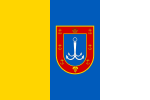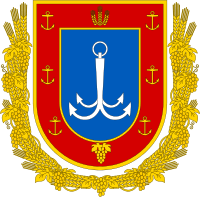Odessa Oblast
| Odessa Oblast Одеська область Odes’ka oblast’ | |||
|---|---|---|---|
| Oblast | |||
| |||
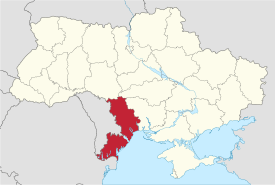 | |||
| Country |
| ||
| Administrative center | Odessa | ||
| Government | |||
| • Governor | Maksym Stepanov | ||
| • Oblast council | 120 seats | ||
| • Chairperson | Mykhailo Shmushkovych | ||
| Area | |||
| • Total | 33,310 km2 (12,860 sq mi) | ||
| Area rank | Ranked 1st | ||
| Population (2015[1]) | |||
| • Total |
| ||
| • Rank | Ranked 6 | ||
| Time zone | UTC+2 (EET) | ||
| • Summer (DST) | UTC+3 (EEST) | ||
| Postal code | 65000-68999 | ||
| Area code | +380-48 | ||
| ISO 3166 code | UA-51 | ||
| Raions | 26 | ||
| Cities (total) | 19 | ||
| • Regional cities | 7 | ||
| Urban-type settlements | 33 | ||
| Villages | 1138 | ||
| FIPS 10-4 | UP17 | ||
| Website | www.odessa.gov.ua | ||
Odessa Oblast (Ukrainian: Одеська область, Odes’ka oblast’, Russian: Одесская область, Odesskaya oblast’) is an oblast (province) of southwestern Ukraine, located along the northern coast of the Black Sea. The oblast consists of the eastern part of the historical region of Novorossiya and the southern part of the historical region of Bessarabia (also known as Budjak). (Budjak, formerly the separate Izmail Oblast (1940-1954), became part of the Odessa Oblast in 1954.) Its administrative center is the city of Odessa (Ukrainian: Одеса, translit. Odesa).
The region, the largest in Ukraine by area, approximates the size of either Belgium or the Netherlands.[2] The length of coastline (sea-coast and estuaries) reaches 300 km (190 mi), while the state border stretches for 1,200 km (750 mi).[2] The region has eight sea-ports, over 80,000 ha (200,000 acres) of vineyards, and five of the biggest lakes in Ukraine.[2] One of the largest, Yalpuh Lake, is as large as the city of Odessa itself.[2]
Odessa, the administrative center of the oblast, is the third-largest city in Ukraine. The town has become known in Ukraine as the "Black Sea Pearl" or as the "Southern Palmyra".[2][3] Odessa became the first city in Ukraine to see a car, with the internal combustion engine brought to the city in 1891 by Vasiliy Navrotskiy, the chief editor of Odesskiy Listok.[2] The founder of Odessa, José de Ribas (1749-1800), brought the lava for making the cobblestones on vulytsia Deribasivska from the Vesuvius volcano near his native Naples.[2] Under that street extend the Odessa catacombs, which have a larger area than the catacombs of Paris or of Rome.
History
Evidence of the earliest inhabitants in this area comes from the settlements and burial grounds of the Neolithic Gumelniţa, Cucuteni-Trypillian and Usatovo cultures, as well as from the tumuli and hoards of the Bronze Age Proto-Indo-Europeans. In the 1st millennium B.C. the Milesian Greeks founded colonies along the northern coast of the Black Sea, including the towns of Olbia, Tyras, Niconium, Panticapaeum, and Chersonesus. The Greeks left behind painted vessels, ceramics, sculptures, inscriptions, arts and crafts that indicate the prosperity of their ancient civilisation.
The culture of Scythian tribes inhabiting the Black Sea littoral steppes in the first millennium B.C. is represented by finds from settlements and burial grounds, including weapons, bronze cauldrons, other utensils, and adornments. By the beginning of the 1st millennium A.D. the Sarmatians displaced the Scythians. In the 3rd–4th centuries A.D. a tribal alliance, represented by the items of Chernyakhov culture, developed. From the middle of the first millennium the formation of the Slavic people began. In the 9th century the Slavs became united into a state with Kiev as its centre. The Khazars, Polovtsy and Pechenegs were the Slavs' neighbours during different times. Archeological evidence of the period of the 9th–14th centuries survives in materials from the settlements and cities of Kievan Rus': Belgorod, Caffa-Theodosia, and Berezan Island.
In 1593 the Ottoman Empire set up in the area what became known as its Dnieper Province (Özü Eyalet), unofficially known as the Khanate of Ukraine.[4] Russian historiography refers to it as the Ochakov Oblast.[5] The territory of the Odessa oblast passed to Russia in 1791 in the course of the Russian southern expansion towards the Black Sea at the end of the 18th century. Subsequently the Russians colonized the area intensively, establishing new cities and ports. In less than a hundred years the city of Odessa grew from a small fortress to the biggest metropolis of New Russia.
After the February Revolution of 1917 in Russia the area became part of the Ukrainian People's Republic (1917-1918), but soon succumbed first to the Russian Volunteer Army (part of the White movement) and then to the Russian Bolshevik Red Army. By 1920 the Soviet authorities had secured the territory of Odessa Oblast, which became part of the Ukrainian SSR. The oblast was established on 27 February 1932 from five districts: Odessa Okruha, Pervomaisk Okruha, Kirovohrad Okruha, Mykolaiv Okruha, and Kherson Okruha.
In 1937 eastern portions of the Odessa Oblast were split to create the Mykolaiv Oblast.
During World War II Romania occupied the oblast and administered it as part of the Transnistria Province (1941-1944). After the war the Soviet administration reestablished the oblast with its pre-war borders.
Odessa Oblast expanded in 1954 to absorb Izmail Oblast (also known as the Budjak region of Bessarabia), formed in 1940 as a result of the Soviet occupation of Bessarabia and Northern Bukovina (from Romania), when Northern and Southern parts of Bessarabia were given to the Ukrainian SSR.
During the 1991 referendum, 85.38% of votes in Odessa Oblast were in favor of the Declaration of Independence of Ukraine. A survey conducted in December 2014 by the Kyiv International Institute of Sociology found 2.3% of the oblast's population supported their region joining Russia, 91.5% did not support the idea, and the rest were undecided or did not respond.[6] A poll by Alexei Navalny found similar results.[7]
Geography
The country's largest oblast by area, it occupies an area of around 33,300 square kilometres (12,900 sq mi). It is characterised by largely flat steppes divided by the estuary of the Dniester river. Its Black Sea coast comprises numerous sandy beaches, estuaries and lagoons. The region's soils are renowned for their fertility, and intensive agriculture is the mainstay of the local economy. The southwest has many orchards and vineyards, while arable crops are grown throughout the region.
Points of interest
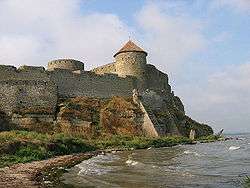
Economy
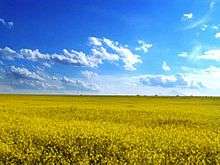
Significant branches of the oblast's economy are:
- oil refining and chemicals processing
- transportation (important sea and river ports, oil pipelines and railway);
- viticulture and other forms of agriculture, notably the growing of wheat, maize, barley, sunflowers and sugar beets.
The region's industrial capability is principally concentrated in and around Odessa.
Demographics
The oblast's population (as of 2004) is 2.4 million people, nearly 40% of whom live in the city of Odessa.
Significant Bulgarian (6.1%) and Romanians (5.0%) minorities reside in the province.[8] It has the highest proportion of Jews of any oblast in Ukraine (although smaller than the Autonomous City of Kiev) and there is a small Greek community in the city of Odessa.
Bulgarians and Romanians represent 21% and 13% respectively, of the population in the salient of Budjak, within Odessa oblast.
| Year | Fertility | Birth |
|---|---|---|
| 1990 | 1,8 | 33 166 |
| 1991 | 1,7 | 32 119 |
| 1992 | 1,6 | 30 155 |
| 1993 | 1,5 | 28 185 |
| 1994 | 1,4 | 26 197 |
| 1995 | 1,4 | 24 993 |
| 1996 | 1,3 | 23 666 |
| 1997 | 1,2 | 22 491 |
| 1998 | 1,2 | 21 273 |
| 1999 | 1,1 | 19 969 |
| 2000 | 1,1 | 20 042 |
| 2001 | 1,1 | 20 423 |
| 2002 | 1,2 | 21 227 |
| 2003 | 1,2 | 22 326 |
| 2004 | 1,3 | 23 343 |
| 2005 | 1,3 | 23 915 |
| 2006 | 1,4 | 25 113 |
| 2007 | 1,5 | 26 759 |
| 2008 | 1,6 | 28 780 |
| 2009 | 1,6 | 28 986 |
| 2010 | 1,6 | 28 690 |
| 2011 | 1,6 | 29 225 |
| 2012 | 1,7 | 30 384 |
Age structure
- 0-14 years: 15.5%

- 15-64 years: 70.7%

- 65 years and over: 14.0%

Median age
- total: 38.4 years

- male: 35.4 years

- female: 41.5 years

Religion
Religion in Odessa Oblast (2015)[9]
The dominant religion in Odessa Oblast is Eastern Orthodox Christianity, professed by 84% of the population. Another 8% declares to be non-religious and 6% are unaffiliated generic Christians. Adherents of Roman Catholicism and Protestantism make up 0.5% of the population respectively.
The Orthodox community of Odessa Oblast is divided as follows:
- Non-denominational - 46%
- Ukrainian Orthodox Church of the Moscow Patriarchate - 31%
- Ukrainian Orthodox Church of the Kyivan Patriarchate - 21%
- Ukrainian Autocephalous Orthodox Church - 1%
- Unknown - 1%
Administrative divisions
The Odessa Oblast is administratively subdivided into 26 raions (districts) and 7 municipalities which are directly subordinate to the oblast government - (Bilhorod-Dnistrovskyi, Chornomorsk, Izmail, Podilsk, Teplodar, Yuzhne and the administrative center of the oblast, Odessa).

| Name | Ukrainian name | Area (km2) | Population 2015[1] | Admin.center | Urban Population Only* |
|---|---|---|---|---|---|
| Odessa | Одеса (місто) | 139 | 1,010,490 | Odessa (city) | 1,010,490 |
| Bilhorod-Dnistrovskyi | Білгород-Дністровський (місто) | 31 | 57,559 | Bilhorod-Dnistrovskyi (city) | 57,559 |
| Chornomorsk | Чорноморськ (місто) | 25 | 72,553 | Chornomorsk (city) | 67,323 |
| Izmail | Ізмаї́л (місто) | 53 | 72,266 | Izmail (city) | 72,266 |
| Podilsk | Подільськ (місто) | 25 | 40,613 | Podilsk (city) | 40,613 |
| Teplodar | Теплодар (місто) | 3 | 10,277 | Teplodar (city) | 10,277 |
| Yuzhne | Южне (місто) | 9 | 32,149 | Yuzhne (city) | 32,149 |
| Ananyiv Raion | Ананьївський (район) | 1,050 | 26,999 | Ananyiv | 8,441 |
| Artsyz Raion ^ | Арцизький (район) | 1,379 | 45,274 | Artsyz | 14,886 |
| Balta Raion | Балтський (район) | 1,317 | 41,666 | Balta | 18,940 |
| Berezivka Raion | Березівський (район) | 1,637 | 33,930 | Berezivka | 12,614 |
| Bilhorod-Dnistrovskyi Raion ^ | Білгород-Дністровський (район) | 1,852 | 60,774 | Bilhorod-Dnistrovskyi (city) | N/A * |
| Bilyayivka Raion | Біляївський (район) | 1,497 | 94,083 | Biliaivka | 14,334 |
| Bolhrad Raion ^ | Болградський (район) | 1,364 | 69,148 | Bolhrad | 15,451 |
| Ivanivka Raion | Іванівський (район) | 1,162 | 26,604 | Ivanivka | 8,807 |
| Izmail Raion ^ | Ізмаїльський (район) | 1,194 | 51,584 | Izmail (city) | N/A * |
| Kiliya Raion ^ | Кілійський (район) | 1,358 | 52,400 | Kiliya | 28,434 |
| Kodyma Raion | Кодимський (район) | 818 | 29,586 | Kodyma | 11,195 |
| Kominternivske Raion | Комінтернівський (район) | 1,499 | 71,158 | Kominternivske | 14,028 |
| Liubashivka Raion | Любашівський (район) | 1,100 | 30,688 | Liubashivka | 10,954 |
| Mykolaivka Raion | Миколаївський (район) | 1,093 | 16,127 | Mykolaivka | 2,850 |
| Ovidiopol Raion | Овідіопольський (район) | 829 | 78,941 | Ovidiopol | 32,486 |
| Okny Raion | Окнянський (район) | 1,013 | 20,186 | Okny | 5,338 |
| Podilsk Raion | Подільський (район) | 1,037 | 27,091 | Podilsk (city) | N/A * |
| Reni Raion ^ | Ренійський (район) | 861 | 58,352 | Reni | 25,527 |
| Rozdilna Raion | Роздільнянський (район) | 1,368 | 37,353 | Rozdilna | 19,003 |
| Sarata Raion ^ | Саратський (район) | 1,474 | 45,057 | Sarata | 4,351 |
| Savran Raion | Савранський (район) | 617 | 19,083 | Savran | 6,420 |
| Shyriaieve Raion | Ширяївський (район) | 1,502 | 27,151 | Shyriaieve | 6,781 |
| Tarutyne Raion ^ | Тарутинський (район) | 1,874 | 41,603 | Tarutyne | 12,932 |
| Tatarbunary Raion ^ | Татарбунарський (район) | 1,748 | 38,825 | Tatarbunary | 10,988 |
| Velyka Mykhailivka Raion | Великомихайлівський (район) | 1,436 | 31,006 | Velyka Mykhailivka | 8,472 |
| Zakharivka Raion | Захарівський (район) | 956 | 20,233 | Zakharivka | 8,881 |
- Note: An asterisk (^) indicates the two municipalities and nine raions which previously constituted Izmail Oblast until that former oblast's merger with Odessa Oblast on 15 February 1954; these areas lie to the west of the Dniester River, and formerly constituted the territory known as the Budjak (southern Bessarabia).
- Note: Asterisks (*) Though the administrative center of the rayon is housed in the city/town that its named after, cities do not answer to the rayon authorities only towns do; instead they are directly subordinated to the oblast government and therefore are not counted as part of rayon statistics.
Notable people
One of the most famous Odessits is Sergei Utochkin who was a universal sportsman exceling in cycling, boxing, swimming and played football for the Odessa British Athletic Club (OBAC).[2] Utochkin had challenged a steam-powered tram while running, on a bicycle he beat a galloping horse, while on roller skates he was passing a bicyclist.[2] The next stage for him was to conquest skies.[2] Utochkin managed to buy an airplane from a local banker and completed dozens of exhibition flights.[2] Eventually, he managed to assemble his own Farman-type airplane.[2] In Kiev, Utochkin was demonstrating his piloting skills in front of some 50,000 people, among which was a future creator of helicopters Igor Sikorsky.[2]
In the Southern Palmyra were also born a poet Anna Akhmatova, former NASA scientist Nicholas E. Golovin who worked with the Apollo program, as well as the founder of jazz in the Soviet Union Leonid Utyosov.[2]
See also
References
- 1 2
- 1 2 3 4 5 6 7 8 9 10 11 12 13 14 Tell about Ukraine. Odessa Oblast. 24 Kanal (youtube).
- ↑ Compare in the European context Saint Petersburg, known as the "Northern Palmyra".
- ↑
Secrieru, Mihaela. "Republic of Moldavia – an Intermezzo on the Signing and the Ratification of the European Charter for Regional and Minority Languages" (PDF). Iași: “Alexandru Ioan Cuza” University of Iaşi. p. 2. Retrieved 2014-09-19.
On the left shore of the River Nistru [Dniester] there was the Khanate of Ukraine and of the properties of the Polish Crown, and their inhabitants, until the end of the 18th century, were the Moldavians[.]
- ↑
Friesen, Leonard G. (2008). Rural Revolutions in Southern Ukraine: Peasants, Nobles, and Colonists, 1774-1905. Harvard series in Ukrainian studies. 59. Harvard University Press. p. 40. ISBN 9781932650006. Retrieved 2014-09-19.
[...] the war with the Ottoman Empire [...] ended with the Treaty of Eternal Peace in December 1791, whereby the so-called Ochakiv (Ochakov) oblast was brought into the empire.
- ↑ Лише 3% українців хочуть приєднання їх області до Росії [Only 3% of Ukrainians want their region to become part of Russia]. Dzerkalo Tyzhnia (in Ukrainian). 3 January 2015.
- ↑ Results of the 2001 All-Ukrainian population census for the Odessa oblast
- ↑ "Religious preferences of the population of Ukraine". Sociology poll by Razumkov Centre, SOCIS, Rating and KIIS about the religious situation in Ukraine (2015)
External links
| Wikimedia Commons has media related to Odessa Oblast. |
